This presentation covers different aspects of influenza preparedness. It describes the disease, vulnerable populations, and how communities can protect themselves from it.
Abstract
- This paper explores influenza preparedness among public housing residents and low income communities.
- Public housing residents and low income populations often report negative health outcomes.
- Preparedness for influenza needs to occur at personal, policy and community levels.
In summary, this paper highlights the multi-level strategies that communities could use to manage and prepare for influenza.
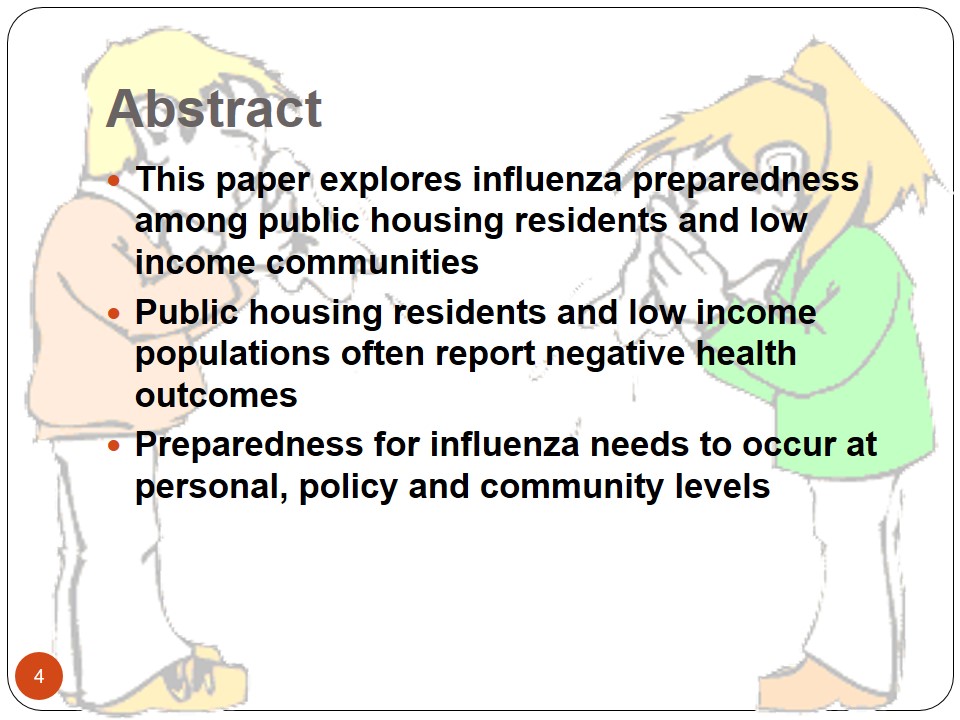
Learning Outcomes
- Formulating culturally competent preparedness and response interventions that address specific needs of public housing residents and low-income population groups.
- Improving public health and community health preparedness against influenza.
- Improving multi-level preparedness against influenza.
At the end of this presentation, we should learn the importance of promoting socially competent health care interventions for preventing influenza. This goal should help to improve the public health and community health preparedness against the pandemic.
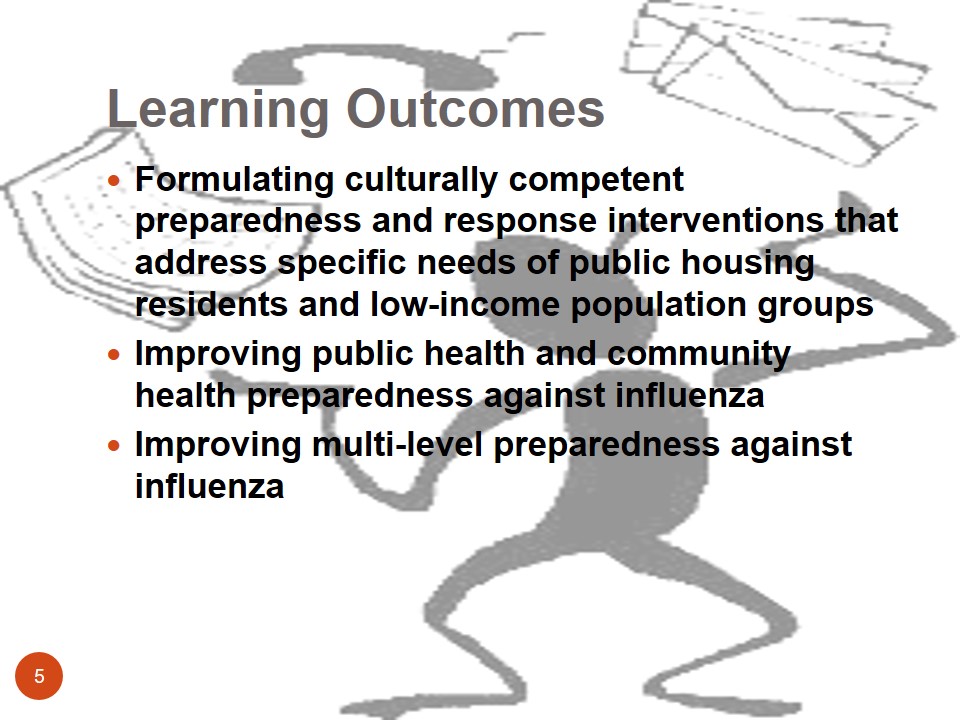
Introduction
- Pandemic Influenza is a serious health concern (Ostrem and Horsburgh, 2008).
- It can cause death and permanent health damage.
- Vulnerable populations are most prone to the disease.
- This paper investigates how low-income populations and people living in housing projects could prepare and respond to the pandemic.
Pandemic influenza affects different types of people. However, this paper mainly focuses on how low-income groups and inhabitants of housing projects could prepare and respond to the disease.

What is Influenza?
- Influenza is a respiratory tract infection.
- Complicated cases of influenza may cause pneumonia and other complicated health issues (Osterholm, 2005).
- Pandemic influenza may be severe and affect many people, as opposed to seasonal influenza (Osha, 2009).
Before embarking on the details of this presentation, it is important to understand influenza as a respiratory tract infection that requires immediate treatment. Unlike seasonal influenza, pandemic influenza is more dangerous to human beings.
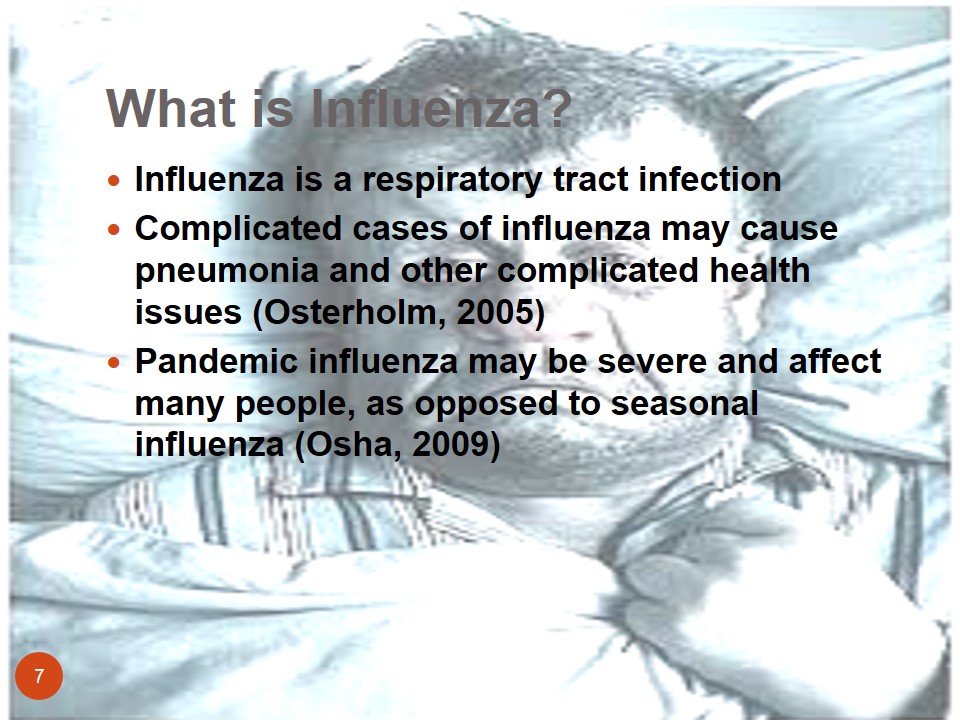
Factors Influencing Vulnerability To Pandemic Influenza
- Poverty.
- Inequities in Health Status.
- Access to Quality of Care.
- Limited Supply to Vaccines.
- Low Immunization Rates.
- Environmental Factors (Krieger, Chen, Rehkopf, Subramanian, 2005).
Pandemic influenza occurs because of poverty, inequities in health status, poor access to quality health care, and low immunization rates among other factors.
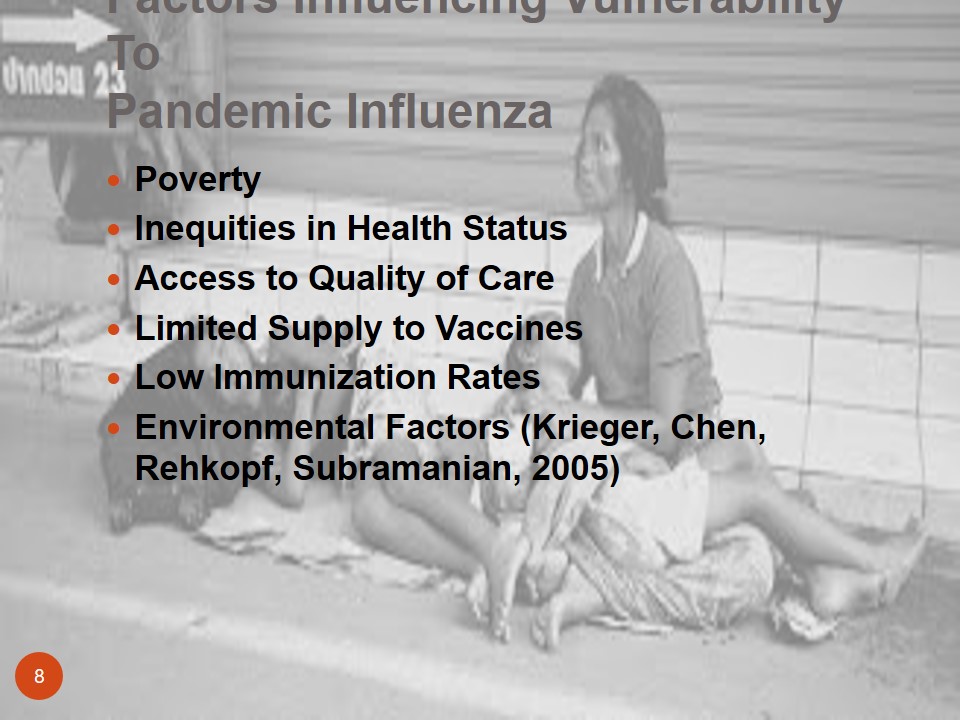
Types of Virus
- Influenza virus A.
- Influenza virus B.
- Influenza virus C.
There are only three types of influenza as shown in this slide. Types B and C do not cause pandemics, but type A does.

Influenza Transmission
- Influenza is airborne because it is transferred through coughs and sneezes.
- Influenza can also be transmitted through contact with contaminated surfaces and bird droppings.
- Airborne aerosols cause the most infections (Compans and Orenstein, 2009).
Pandemic influenza spreads fast because it is airborne. Airborne aerosols cause the most infections to human societies.
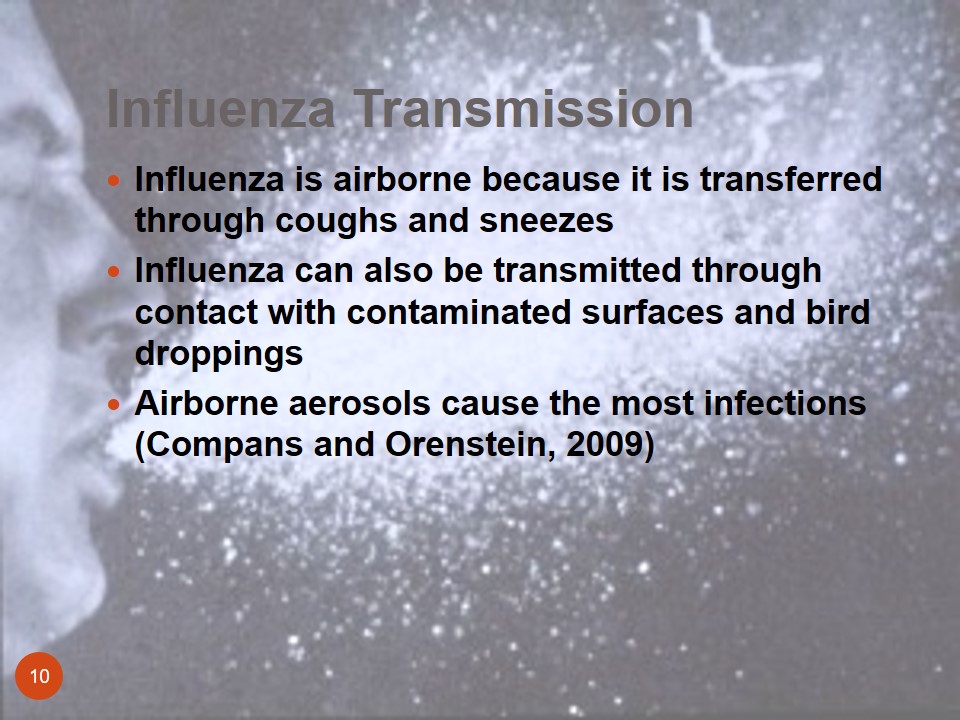
Why Focus on Public Housing People?
- The US Department of Housing and Urban development funds operating procedures of more than 3.4 million public houses (Bouye et al., 2009).
- There are about 1.5 million people living in these public houses and most of them have low-incomes.
- They live in congested areas.
Inhabitants of public housing are more vulnerable to pandemic influenza because they form a significant percentage of the US population that lives in abject poverty and reside in congested areas. These dynamics support the spread of the disease.
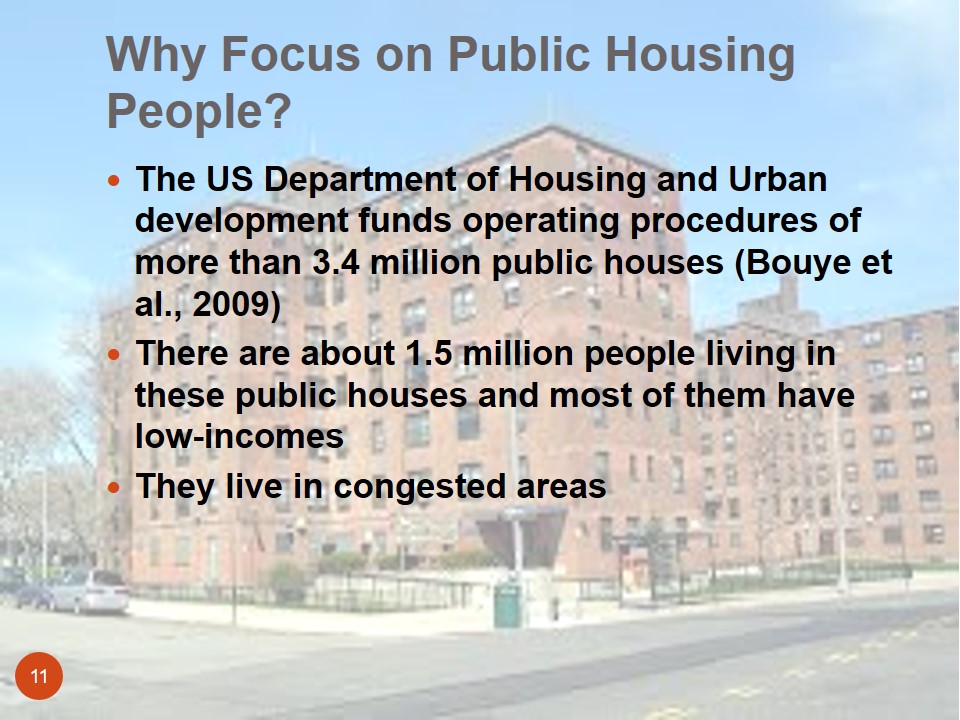
Why Focus on Low-Income People?
- Low-Income people often juggle multiple jobs and could skip vaccination because of limited time (Rocheleau, 2013).
- Low-income people could avoid seeking health care because of demanding work schedules.
- Low-income people live in congested areas that often lead to the faster spread of influenza.
Similar to inhabitants of public housing, low-income people often have multiple jobs that either prevent them from seeking quality health care treatment, or influenza vaccinations.
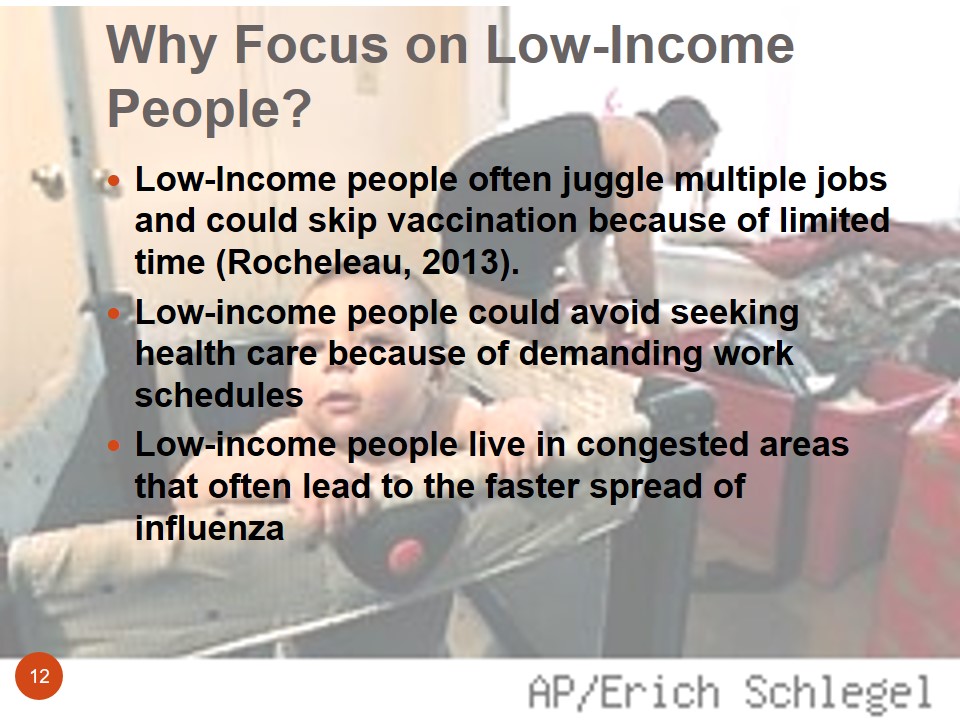
Address to the Public How to Care for People with influenza
- Keep a care log.
- Keep the patient rested.
- Keep tissues and trash bag close to the patient.
- Use ibuprofen or acetaminophen or other measures, as recommended by your healthcare provider.
- Make sure patient does not drink and smoke (CDC, 2008).
- Give patient plenty of fluids.
- Do not use aspirin because it may cause the Reye syndrome or a life-threatening illness.
- Watch out for signs of dehydration.
- Watch out for complications of influenza (Meltzer, 2008).
It is important for the public to protect themselves from influenza. However, when they have to take care of infected people, they need to understand how to keep a care log, keep the patient rested, and make sure the patient does not drink or smoke. These measures help to manage the disease and minimize its spread.
Since many influenza patients vomit, people should give them plenty of water and watch out for signs of dehydration. Care givers should also refrain from administering other drugs, such as aspirin, because they may cause new health complications.

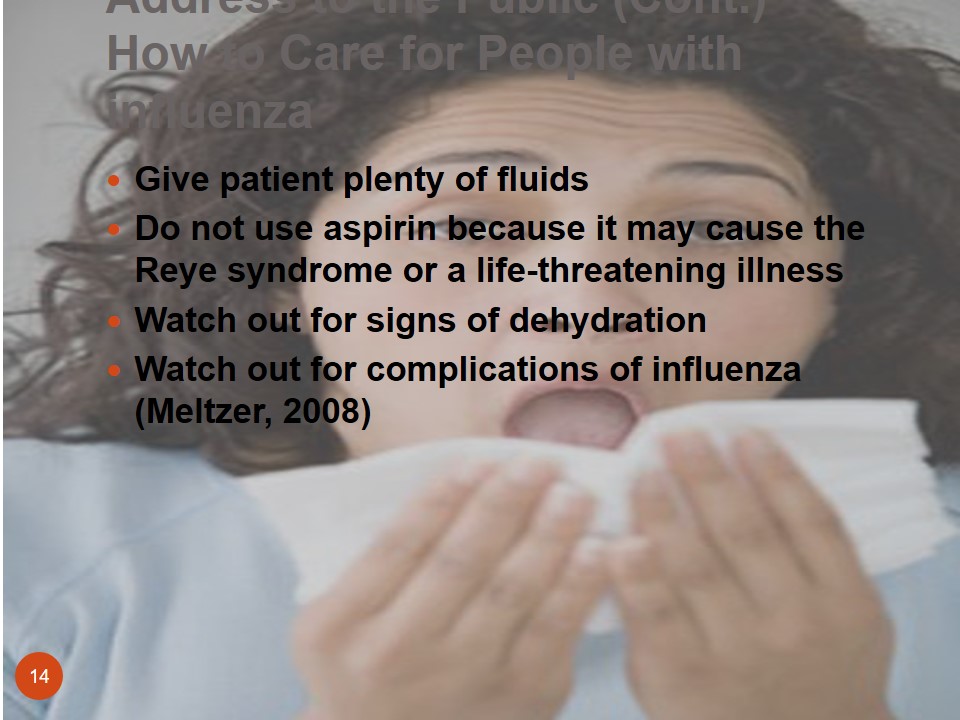
Address to Public Housing Residents
Residents of public housing should be more concerned about influenza because they live in crowded places, they suffer from chronic health conditions that could affect their immune systems, they suffer from severe mental health conditions (compared to the general population) that could affect their treatment, and may not seek care until they are very sick (Armstrong, Berlin, Schwartz, Propert, Ubel, 2001).
Inhabitants of public houses are often vulnerable to influenza because they live in unfavorable conditions that may support the spread of influenza. For example, most public housing projects are overcrowded, thereby supporting the spread of influenza. Similarly, personal health factors, such as adverse mental health conditions and the predisposition to stress factors also make them vulnerable to influenza.
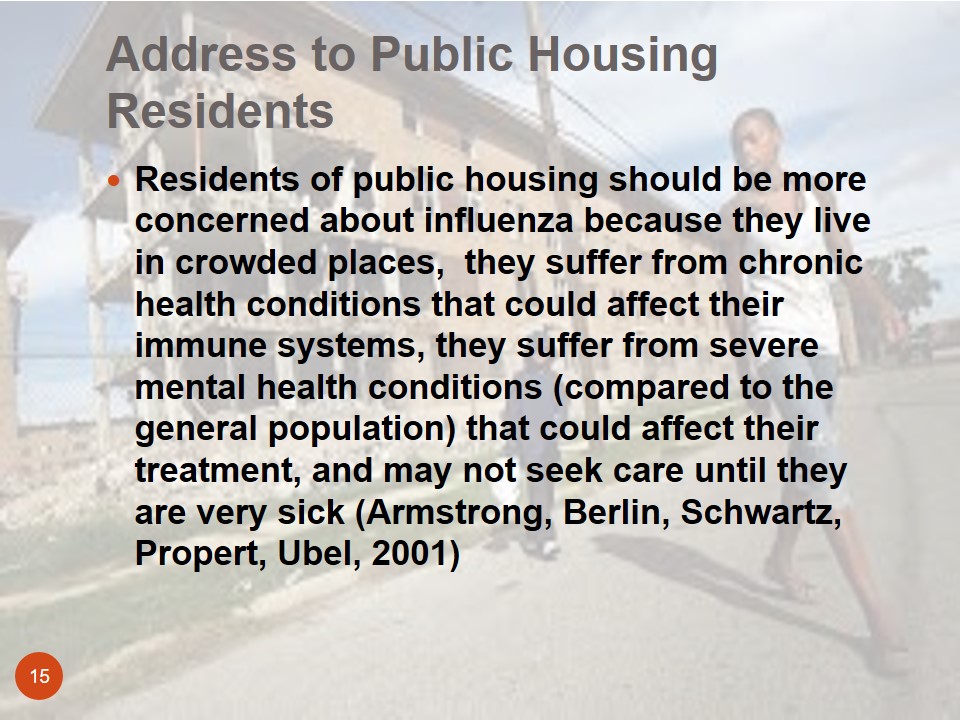
Address to Low-Income Populations
- Develop family and personal preparedness plan.
- Attend health education training programs.
- Stockpile supplies.
- Refine personal infection control policies.
- Put hand sanitizers in conspicuous places.
- Forge crucial partnerships with health agencies.
Low-income populations need to take proper care to prevent themselves from influenza because they are more vulnerable to the disease, compared to people from other income groups. In this regard, they need to develop their family preparedness plans, attend health education training programs, and forge crucial partnerships with health agencies. Personally, they need to stock emergency supplies, refine personal infection control policies, and put hand sanitizers in conspicuous places. These measures would improve their preparedness to influenza.
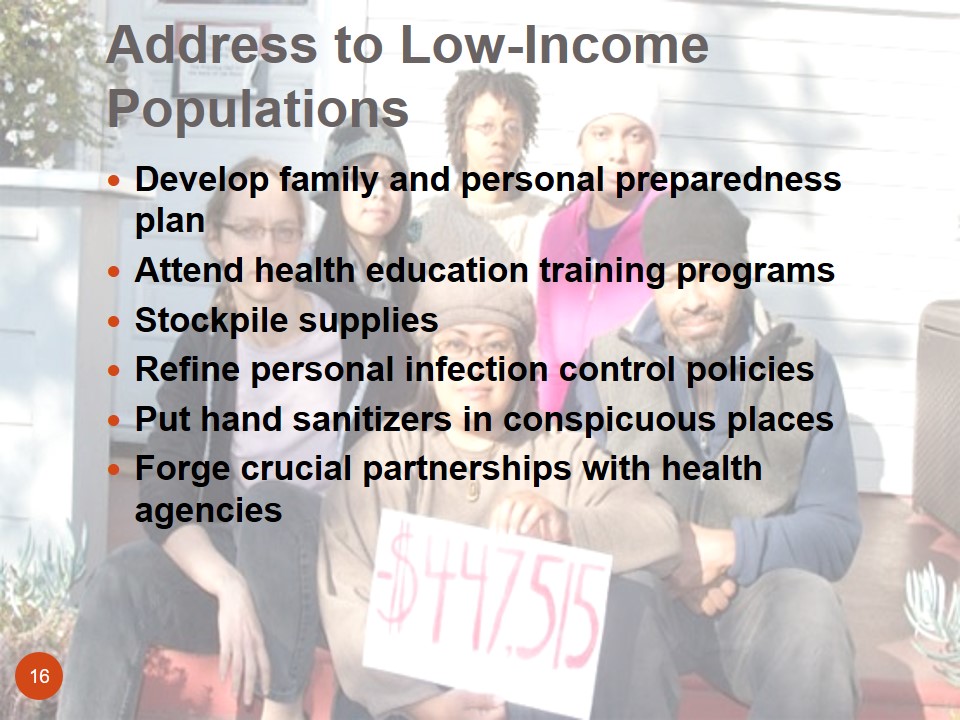
Address to Low-Income Populations (What Everyone in the House can do)
- Wash hands with soap and water.
- Do not touch hands, nose, or mouth without washing hands first.
- Wash soiled utensils with hot water (using hands or dishwasher).
- Wash Clothes in a standard washing machine with cold or hot water.
- Clean home surfaces regularly.
Most measures for preventing influenza should involve all members of the house. They include personal hygiene factors such as washing hands with soap, refraining from touchin contaminated surfaces, washing clothes in standard washing machines, and cleaning household surfaces regularly.

Address to Policy Makers
- Make influenza vaccinations mandatory for people in public housing projects.
- Vaccinate farm poultry to reduce infection rates.
- Increase channels of communication between community members and healthcare service providers (Blumenshine et al., 2008).
Policy makers should make sure they support the efforts of health care workers by introducing legislations that make vaccination mandatory for inhabitants of public housing projects and low income groups. They should also stretch the same policy to include all poultry. Lastly, they need to create legislative measures that increase the channels of communication between communities and health workers.

Role of Department of Health
- Disease surveillance and reporting.
- Case Investigation and Management.
- Identification of influenza cases and following up on afflicted individuals.
- Health risk assessment and communications.
- Liaison with other stakeholders in the health sector.
- Vaccine distribution (Stoto, 2008).
The Department of Health plays the most important role in influenza preparedness. It should conduct disease surveillance and reporting, investigate infections, assess health risks to human populations, distribute vaccines and provide recommendations for preventing future infections.

Community Interventions
- Voluntary isolation and treatment of ill persons.
- Asking household members of ill persons to stay at home (quarantine).
- Limiting or prohibiting large public gatherings.
- Voluntary social distancing.
Communities are important stakeholders in influenza preparedness and response. People should be willing to isolate ill people (voluntarily), limit large public gatherings, and practice social distancing. These measures would limit the spread of the pandemic, if it occurs.
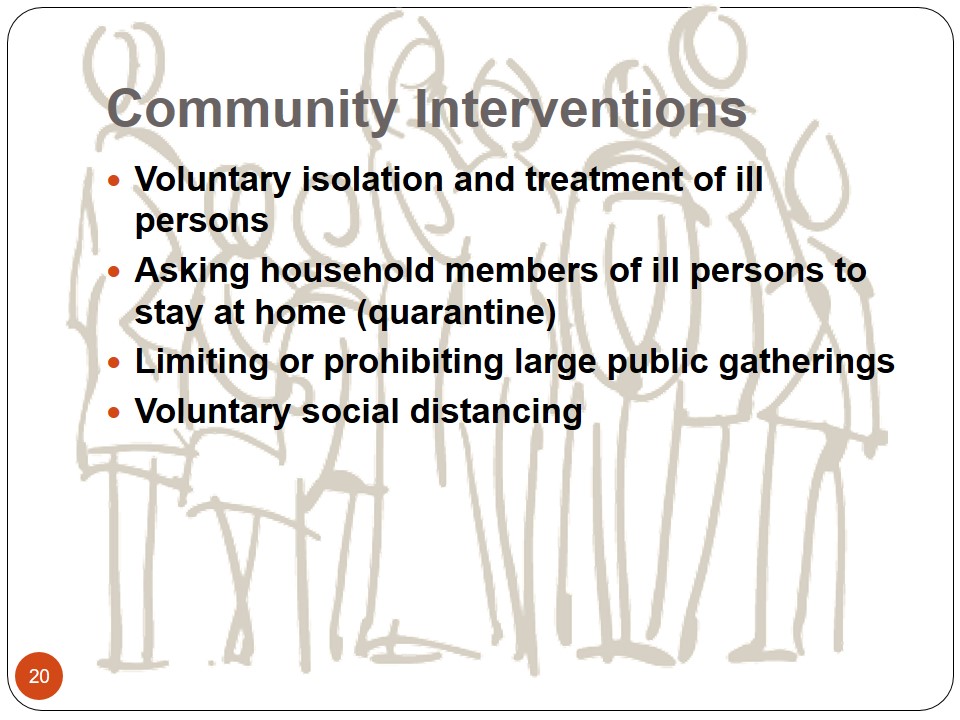
Issues Requiring Further Community-Level Planning
- Additional training opportunities between communities and health workers.
- Increased communication networks.
- Assign designated areas for sick people (Seattle Public Health County, 2006).
Since community-level planning is broad, there needs to be broader efforts to increase communication between community members and health care workers, create additional training opportunities between community members and health care workers, and assign designated areas for sick people.
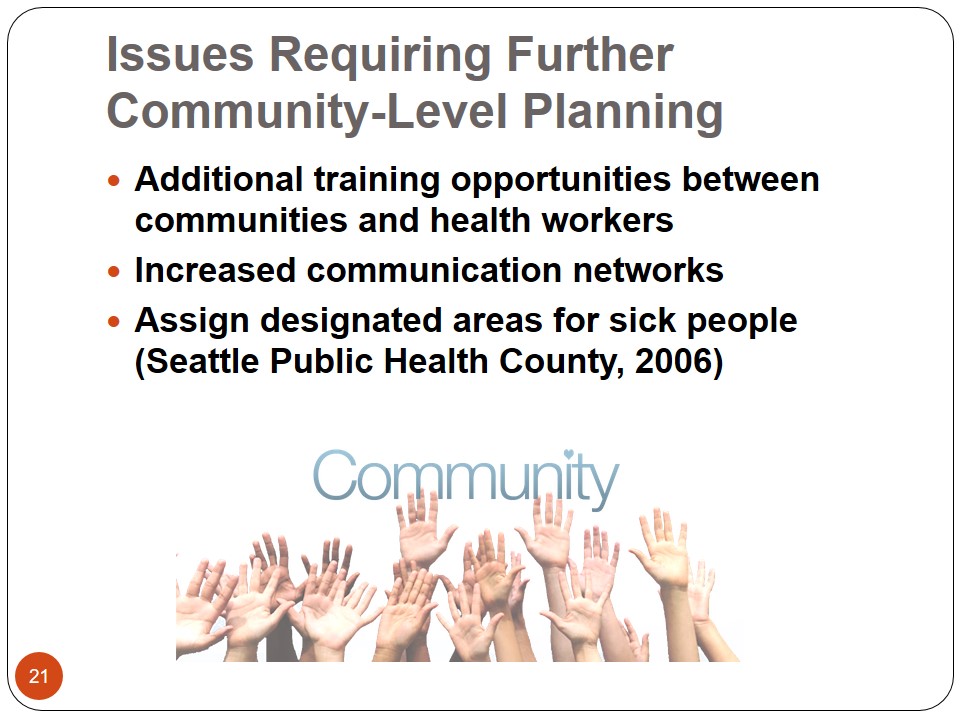
Interventions for the Department of Housing and Urban Development
- Increase house spacing to decrease congestion.
- Provide proper drainage in housing projects to improve sanitation.
- Improve ventilation in housing projects.
- Provide proper waste disposal mechanisms (Steinhardt , 2010).
The Department of Housing and Urban development needs to reduce the incidence of influenza among inhabitants of public housing by increasing house spacing (to decrease congestion), providing proper drainage, improving ventilation, and providing proper waste disposal mechanisms. These measures would improve the living conditions of public housing residents.
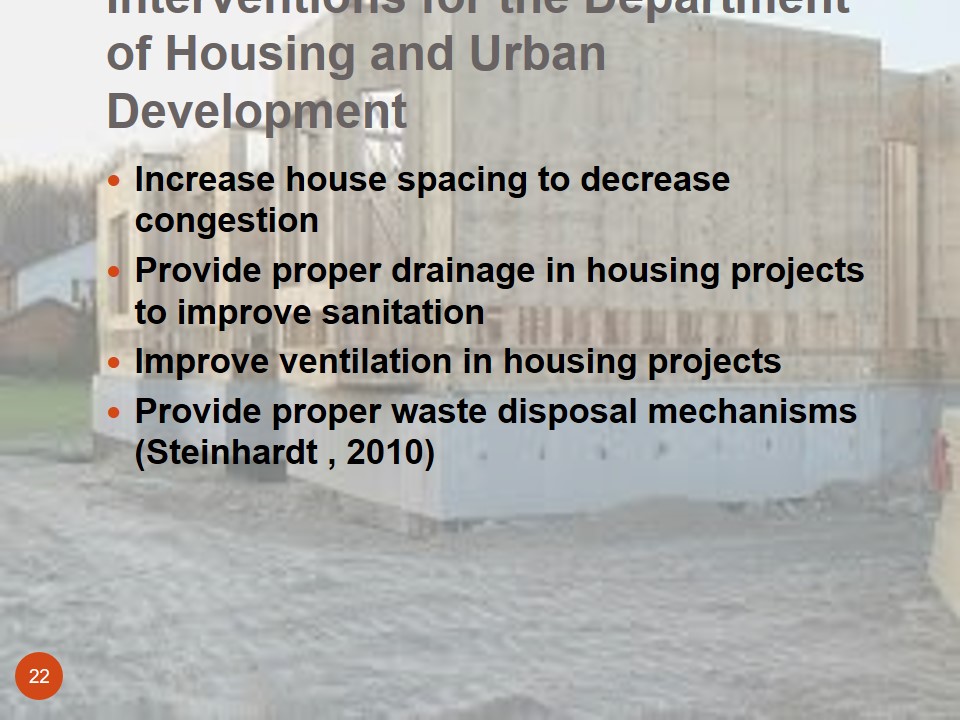
General Recommendations
- Community mobilization and partnerships.
- Culturally specific emergency communications planning.
- Culturally specific education and training programs.
- Evidence-based measurement and evaluation efforts.
- Strategic planning policies.
- Inclusion of community members as partners.
- Policy and program changes to minimize morbidity and mortality (Holmberg, Layton, Ghneim, Wagener, 2006).
All health, community, and policy stakeholders need to take a proactive approach to prepare and respond to an influenza pandemic. Such measures need to include a concerted effort to create strategic planning policies, introduce policy changes to minimize morbidity and mortality, forge community mobilization and partnerships, and create culturally-specific emergency communication and planning.
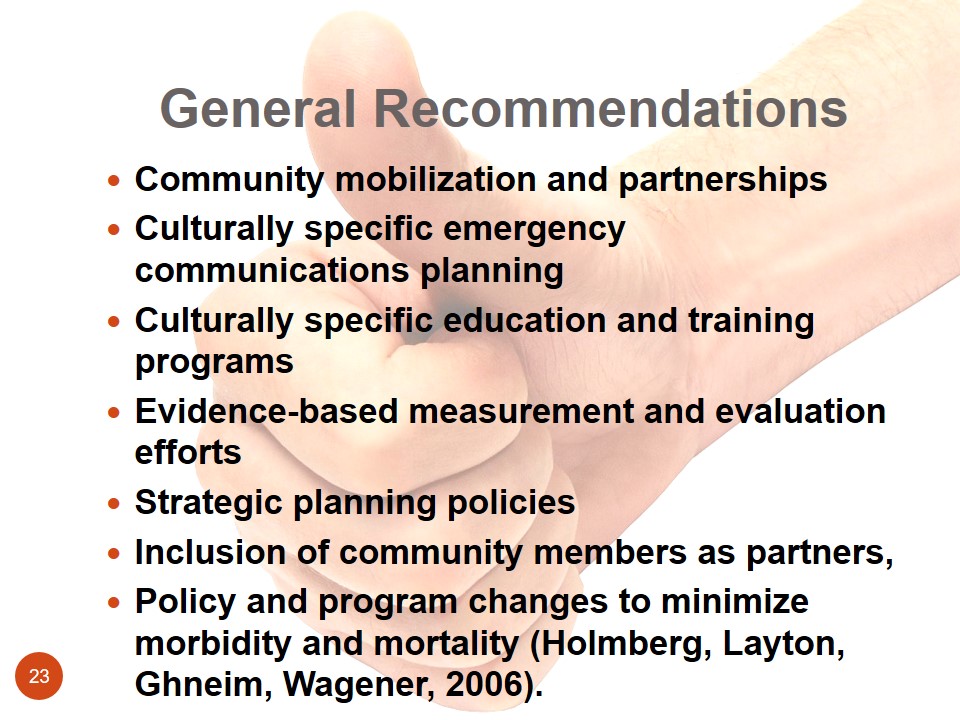
Conclusion
- The learning outcomes of the paper aimed to educate the public about influenza as a public health concern and formulate culturally competent preparedness and response interventions that address specific needs of public housing residents and low-income population groups.
- The paper covered key areas of influenza preparedness including describing the nature of influenza, vulnerable populations, and possible interventions for improving community preparedness.
- This paper finds that low income populations and people living in housing projects are vulnerable to pandemic influenza.
- There should be a multifaceted approach to prevent influenza.
- The multifaceted approach should include communities, policy makers, individuals, and the Department of Public Health.
Preparing and responding to an influenza pandemic requires people to make informed choices regarding how to manage vulnerable populations and how to provide culturally-specific interventions for curbing the pandemic. This paper proposes the introduction of a multifaceted approach for doing so. It should include key stakeholders, such as communities, policy makers, individuals, and the Department of Public Health.
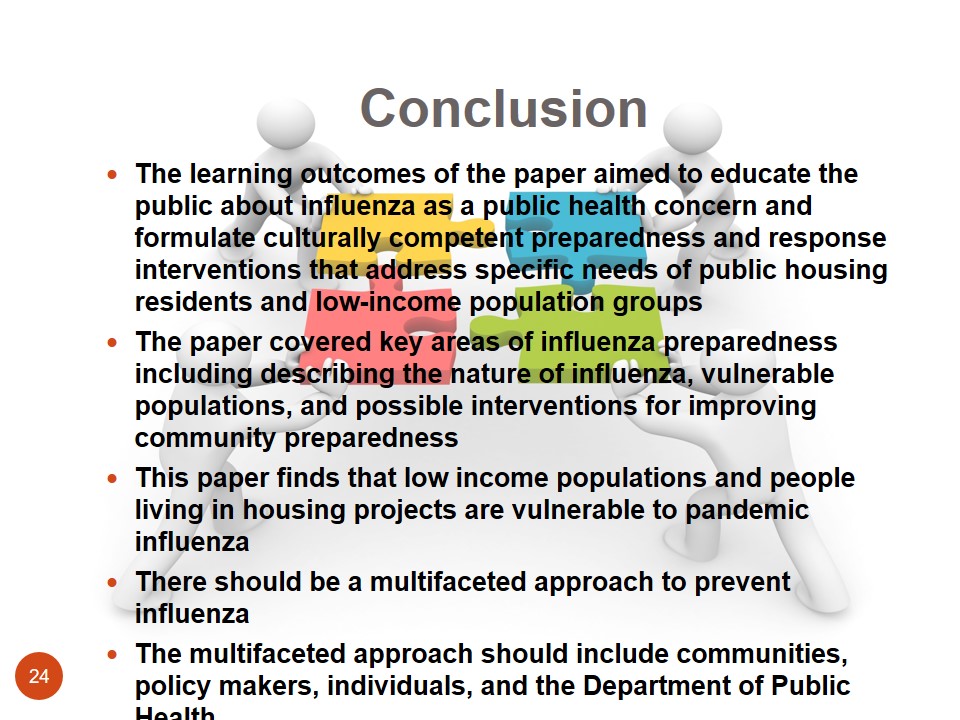
Questions
- What is Influenza?
- What is the difference between seasonal and pandemic influenza?
- What are some recommended strategies for protecting communities against influenza?
- How can communities minimize influenza transmission?
These questions aim to enforce the learning outcomes of this paper. They cover important areas of influenza preparedness and management.
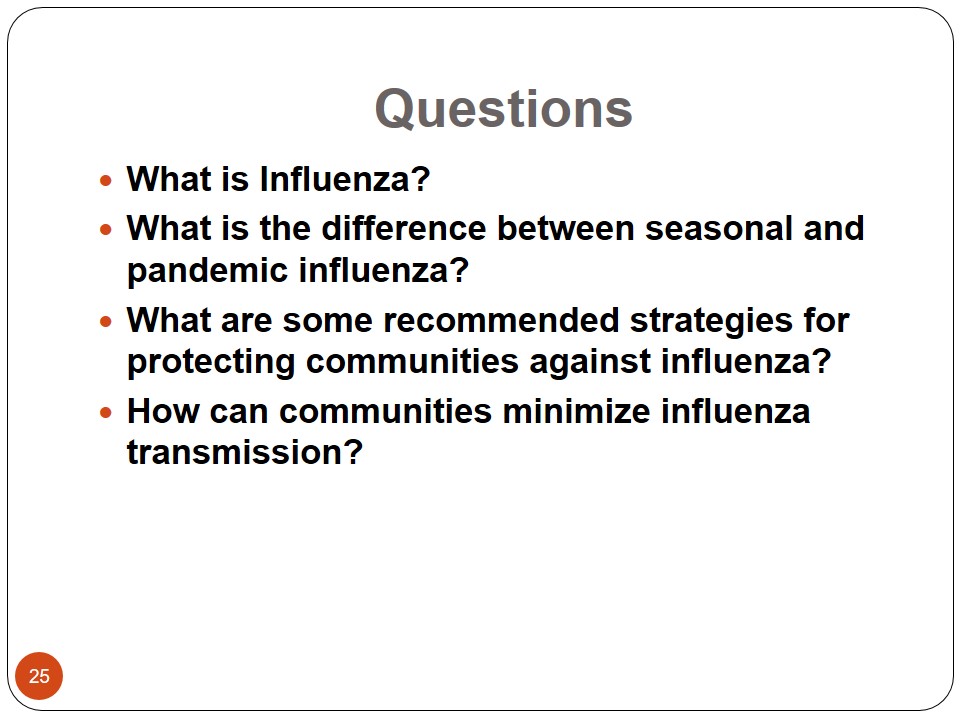
References
Armstrong, K., Berlin, M., Schwartz, J. S., Propert, K., Ubel, P. A. (2001). Barriers to influenza immunization in a low-income urban population. Am J Prev Med, 20(1), 21–25.
Blumenshine, P., Reingold, A., Egerter, S., Mockenhaupt, R., Braveman, P., Marks, J. (2008). Pandemic influenza planning in the United States from a health disparities perspective. EmergInfec Dis, 14(5), 709–715.
Bouye, K., Truman, B., Hutchins, S., Richard, R., Brown, C., Guillory, J. (2009). Pandemic Influenza Preparedness and Response Among Public-Housing Residents, Single-Parent Families, and Low-Income Populations. American Journal of Public Health, 99(2), 287-293.
CDC. (2008). Interim guidance on planning for the use of surgical masks and respirators in health care settings during an influenza pandemic. Web.
Compans, R., & Orenstein, W. (2009). Vaccines for Pandemic Influenza. New York, NY: Springer Science & Business Media.
Holmberg, S., Layton, C., Ghneim, G., & Wagener, D. (2006). State plans for containment of pandemic influenza. Emerg Infect Dis, 12(9), 1414–1417.
Krieger, N., Chen, J. T., Rehkopf, D. H., & Subramanian, S. V. (2005). Painting a truer picture of US socioeconomic and racial/ethnic health inequalities: the Public Health Disparities Geocoding Project. Am J Public Health, 95(1), 312–323.
Meltzer, M. (2008). Pandemic influenza, reopening schools, and returning to work. Emerg Infect Dis, 14(3), 509–510.
Osha. (2009). Pandemic Influenza Preparedness and Response Guidance for Healthcare Workers and Healthcare Employers. Web.
Osterholm, M. (2005). Preparing for the next pandemic. N Engl J Med, 352(18), 1839–1842.
Ostrem, M., & Horsburgh, C. R. (2008). Use of a population-based survey to describe the health of Boston public housing residents. Am J Public Health, 98(1), 85–91.
Rocheleau, M. (2013). Boston’s lower-income areas bear brunt of flu. Web.
Seattle Public Health County. (2006). An Influenza Pandemic Planning Guide for Homeless and Housing Service Providers. Web.
Steinhardt , B. (2010). Influenza Pandemic: Greater Agency Accountability Needed to Protect Federal Workers in the Event of a Pandemic: Congressional Testimony. New York, NY: DIANE Publishing.
Stoto, M. A. (2008). Regionalization in local public health systems: variation in rationale, implementation, and impact on public health preparedness. Public Health Rep, 123(4), 441-449.
Additional Reading
Vaughn, E., & Tinker T. (2009). Effective health risk communication about pandemic influenza for vulnerable populations. Am J Public Health, 99(2),324–S332.
World Health Organization. (2008). Pandemic Influenza Preparedness and Mitigation in Refugee and Displaced Populations. Web.